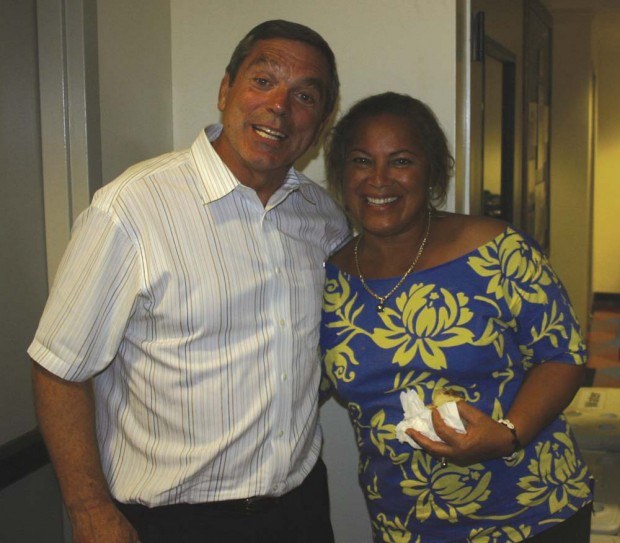WAIMEA — Blessed with some of the purest seawater in the world and sunny growing conditions, the owners of the Kekaha shrimp farm have big plans for their small operation.
Currently producing white shrimp mainly for local consumption and broodstock for export around the world, Sunrise Capital, owned by the Mainland-based Integrated Aquaculture International, has plans to eventually produce everything from kahala, moi, oysters, clams, seaweed, even algae to produce jet fuel.
That makes them, as Dr. Carl Berg of Lihu‘e says, a concentrated aquatic animal production facility, something Dr. George Chamberlain agrees with.
Chamberlain is a director of Integrated Aquaculture International and president of the Global Aquaculture Alliance (gaalliance.org), and conducted a two-hour informational meeting about the Kekaha aquaculture farm at the Waimea Theatre, just before a state Department of Health public hearing on the farm’s application for a permit necessary to discharge farm effluent into the ocean.
The DOH will either approve or deny the continuation of the National Pollution Discharge Elimination System permit, required by the federal Environmental Protection Agency and monitored by DOH.
Public comments on the permit are being accepted by the DOH through 4:30 p.m. Dec. 3, and may be e-mailed to cleanwaterbranch@doh.hawaii.gov or via U.S. mail to Clean Water Branch (CWB), Environmental Management Division, State Department of Health, 919 Ala Moana Blvd., Room 301, Honolulu, HI 96814-4920.
Copies of the proposed draft permit and other information are available online at www.hawaii.gov/health/environmental/water/cleanwater/_index.html, or for inspection at the DOH Kaua‘i District Health Office, 3040 ‘Umi St. in Lihu‘e, weekdays except holidays and furlough days from 7:45 a.m. to 4:15 p.m.
The farming portion of the operation breaks even at its current scale, and the company is making money on its broodstock operation, located around two miles south of the farm, which is on the Mana Plain adjacent to the U.S. Navy Pacific Missile Range Facility at Barking Sands, said Chamberlain. Any profits are immediately put back into facility development, he said. Chamberlain’s company purchased the farm from a hui of local businessmen that quickly found out after they bought the facility that shrimp-farming is much more technical than they had planned for, he said.
Chamberlain had been managing hatcheries in Asia that had been buying broodstock from the Kekaha facility, so knew of the potential of the Westside facility. “We were super impressed with the operation,” which he called the “Cadillac” of shrimp farms because of the pure seawater very close to the facility.
In other places around the world, Chamberlain and company have spent lots of money on water quality, and that effort produces water that still doesn’t come near Kekaha’s quality, he said. He and others saw that it wasn’t going to take enormous investments of money at Kekaha “to get it in order.” The seawater brought to the facility and filtered through lava rock comes to the farm almost-nutrient-free and bacteria-free, he said.
While the broodstock portion of the operation competes against some of the top companies in the world, the fresh market is exclusively local, an advantage that means the shrimp can be sold immediately after harvest and without any processing needed. “Hawai‘i is really a premium market,” and if he had his druthers he would sell everything he harvests on Kaua‘i or in Hawai‘i, he said.
In his business, “SPF” does not stand for “sun protection factor,” but “specific pathogen free,” meaning the shrimp are disease-free and hence fast-growing.
The company is taking extraordinary measures to keep in that way, a tall order in an industry that averages discovery of a new shrimp virus once a year. It was the white-spot syndrome virus that signaled the doom of Sunrise Capital’s former owner, forcing destruction of the entire crop.
Chamberlain thinks birds dining on imported frozen shrimp discarded at the nearby Kekaha Landfill then visiting the farm likely left behind the virus that wiped out the former shrimp crop.
Among the efforts of the new entity was installation of netting over all of the ponds, to keep birds from swooping in for free lunches and, potentially, leaving behind devastating diseases and viruses.
The company has assembled a team of industry experts, including Jim Sweeney, general manager, who was with the Oceanic Institute on O‘ahu and, before that, the Fujinaga Penaeid Shrimp Institute in Japan, before coming to Kekaha, Chamberlain said.
“This (team) gives us an edge, we think, in solving problems,” said Chamberlain.
Among the complaints from surfers and other beach users — effluent from the farm is legally discharged into the ocean near a popular surf break near Kekaha Beach Park known as Kinikinis — is that nasty smells emanated from the farm or discharge.
Chamberlain said his team has identified dead and decaying tilapia in the nearby ditch system as the culprit, and has instituted measures to control the tilapia, and keep them from getting into the farm system.
The company is also plunging headlong into producing algae that may be converted to jet fuel, a project that is enjoying federal funding through the Defense Advanced Research Projects Agency, he said.




